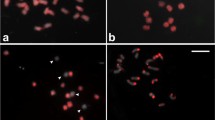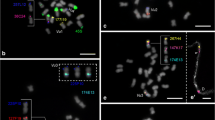Abstract
Apomixis is a means of asexual reproduction by which plants produce embryos without fertilization and meiosis, therefore the embryo is of clonal and maternal origin. Interspecific hybrids between diploid B. vulgaris (2n=2x=18) and tetraploid B. corolliflora (2n=4x=36) were established, and then back-crossed with B. vulgaris. Among their offspring, monosomic addition line M14 (2n=2x=18+1) was selected because of the apomictic phenotype. We documented chromosome transmission from B. corolliflora into M14 by using genomic in situ hybridization (GISH). Suppression of cross-hybridization by blocking DNA was not necessary, indicating that the investigated Beta genome contains sufficient species-specific DNA, thus enabling the determination of genomic composition of the hybrids. We analyzed BAC microarrays of B. corolliflora chromosome 9 by using fluorescence-specific mRNA of B. vulgaris and Beta M14. BAC clones 16-M11 and 26-L15 were detected as fluorescence-specifics of BAC DNA of Beta M14. Then both BAC clones 16-M11 and 26-L15 were in situ hybridized to M14 chromosomes. The two hybridized BAC clones were located close to the telomere region of the long arm of a single chromosome 9, and showed hemizygosity. The results of BAC microarrays showed that these developments of embryo and endosperm have conservative expression patterns, indicating that sexual reproduction and apomixis have an interrelated pathway with common regulatory components and that the induction of a modified sexual reproduction program may enable the manifestation of apomixis in Beta species. It would be sufficient for the expression of apomixes with those apomictic-specific genes on chromosome 9 of B. corolliflora.
Similar content being viewed by others
References
Nogler G A. Genetics of apospory in apomictic Ranunculus auricomus. Embryology of Angiosperms, 1984, 94: 411–422
Asker S E, Jerling L. Apomixis in Plants. Boca Raton: CRC Press, 1992
Koltunow A M. Apomixis: Embroy sacs and embryos formed without meiosis or fertilization in ovules. Plant Cell, 1993, 5: 1425–1437
Grimanelli D, Leblanc O, Perotti E, et al. Develpmental genetics of gametophytic apomixes. Trends Genet, 2001, 17: 597–604
Leblanc O D, Grimanelli D, Gonzalez-de-leon, et al. Detection of the apomictic mode of reproduction in maize-Tripsacum hybrids using maize RFLP markers. Theor Appl Genet, 1995, 90: 1198–1203
Savidan Y. Transfer of apomixis through wide crosses. The Flowering Engineering, Houston: Cimmy, 2001
Dujardin M, Hanna W. Developing apomictic pearl millet-characterization of a BC. Plant J Breed, 1989, 43: 145–151
Letschert J P W. Beta section: Biogenographical Patterns of Variation and Taxonomy. Wageningen Agric Univ, 1993, 93: 1–155
Guo D D, Li S C, Jia S B, et al. Study of interspecific hybridization in sugar beet. J Heilonjiang Univ (natural science edition) (in Chinese), 1999, (2): 108–113
Liu L P, et al. Karyotype analysis of offsprings that producted by interspecific hybrids between diploid B. vulgaris and teraploid B. corolliflora. China Sugar Material (in Chinese), 1996, (3): 1–5
Gao D J, et al. Monosomic addition lines that B. corolliflora chromosome added to the B. vulgaris complement. China Sugar Material, 2001, (4): 1–5
Guo D D, Lui L P, Kang C H. Propagation and transmitting characteristics of apomictic monosomic additions Beta M14. J Heilonjiang Univ (natural science edition) (in Chinese), 2001, 18(3): 104–107
Gao D, Schmidt T, Jung C. Molecular characterization and chromosomal distribution of species-specific repetitive DNA sequences from B. corolliflora, a wild relative of sugar beet. Genome, 2000, 43(6): 1073–1080
Desel C, Jung C, Cai D, et al. High resolution mapping of YACs and single-copy gene Hsl pro-1 on Beta vulgaris chromosomes by multi-colour fluorescence in situ hybridization. Plant Mol Biol, 2001, 45: 113–122
Schmidt T, Schwarzacher T, Heslop-Harrison J S. Physical mapping of rRNA genes by fluorescent in situ hybridization and structural analyses of 5s rRNA genes and intergenetic spacer sequences in sugar beet (Beta vulgaris). Theor Appl Genet, 1994, 88: 629–636
Yan H H, Cheng Z K, Liu G Q, et al. Identification of Oryza×Oryza officinalis F1 and backcross progenies using genomic in situ hybridization. Acta Genet Sin (in Chinese), 1999, 26: 1–157
Ozias-Akins P, Roche D, Hanna W W. Tight clustering and hemizygosity of apomixis-linked molecular markers in Pennisetum squamulatum implies genetic control of apospory by a divergent locus that may have no alleles form in sexual genotypes. Proc Natl Acad Sci USA, 1998, 95: 5127–5132
Dean C, Schmidt R. Plant genomes: A current molecular description. Annl Rev Plant Mol Biol, 1995, 46: 395–418
Christing D, Rita J, Gue D D, et al. Painting of parental chromatin in Beta hybrids by multicolour fluorescent hybridization. Annals of Botany, 2002, 89: 171–181
Flavell A J, Smith D B, Kumar A. Extreme heterogeneity of Ty1-copia group retrotransposons in plants. Molecular and General Genetics, 1992, 231: 233–242
Hirochiksa H, Hirochika R. Ty1-copia group retrotransposon as ubiquitous components of plant genomes. Jap J Genet, 1993, 68: 35–46
Brandes A, Jung C, Wricke G. Nematode resistance derived from wild beets and its meiotic stability in sugar beet. Plant Breeding, 1987, 99: 56–64
Gindullis F, Desel C, Calasso I, et al. The large-scale organization of centromeric DNA in Beta species. Genome Research, 2001, 11(2): 253–265
Ozias-Akins P, Lubber E L, Hanna W W, et al. Transmission of the apomictic mode of reproduction in Pennisetum: Co-inheritance of the trait and molecular marks. Theor Appl Genet, 1993, 85: 632–638
Savidan Y. Transfer of apomixes through wide crosses. In: Savidan Y, Carman J G, Dresselhaus T, eds. The Flowering of Apomixis from Mechanisms to Genetic Engineering. Houston: Cimmy, 2001
Tucker M R, Araujo A C G, Peach N A, et al. Sexual and apomictic reproduction in Hirracium subgenus pilosella are closely inherilated developmental pathways. The Plant Cell, 2003, 15: 1524–1537
Zhang L T, Pickering R, Murray B. Direct measurement of recombination frequency in interspecific hybrids between Hordeum vulgare and H. bulbosum using genomic in situ hybridization. Heredity, 1999, 83: 304–309
Tas I C Q, Van Dijk P. Crosses between sexual and apomictic dandelions(Taraxacum), I. The inheritance of apomixis. Heredity, 1999, 83: 707–714
Van Dijk P, Tas I C Q, Falque M. Crosses between sexual and apomictic dandelions(Taraxacum). H. The breakdown of apomixis. Heredity, 1999, 83: 715–721
Author information
Authors and Affiliations
Corresponding author
Additional information
Supported by the National Transgene Scientific Program (Grant No. JY03A2402) and the Postdoctoral Science Foundation of Heilongjiang Province
Rights and permissions
About this article
Cite this article
Ge, Y., He, G., Wang, Z. et al. GISH and BAC-FISH study of apomictic Beta M14. SCI CHINA SER C 50, 242–250 (2007). https://doi.org/10.1007/s11427-007-0018-0
Received:
Accepted:
Issue Date:
DOI: https://doi.org/10.1007/s11427-007-0018-0




